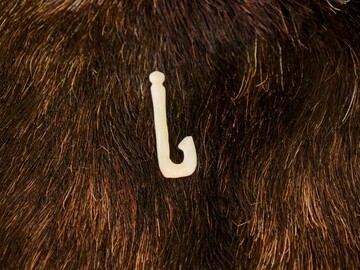Bone Fishing Hook
- Material
- Bone
- Author/Maker
- Reproduction produced by Plimoth Patuxet Museums

Description
Fishing has been an essential part of Wampanoag daily life for thousands of years. Men typically fished in the fresh-water ponds and rivers for herring, trout, perch, catfish and eels. In the spring of 1621, the English writers of Mourts Relation observed Tisquantum fishing for eels: “at night he came home with as many as he could well lift in one hand… he trod them out with his feet, and so caught them with his hands without any other instrument.”1
Wampanoag men also fish in the saltwater ocean for cod, sturgeon, tautog, pollock, bluefish, flatfish, bass, sea eels, mackerel and others. Drift-whaling - harvesting whales who washed ashore - was also practiced.
Common fishing techniques still practiced today include netting, spearing or harpooning, setting up fishing weirs (pots or traps) to direct fish into an enclosed area to make it easier to remove with nets, spears, or by hand, and angling with hooks and line. Fish hooks were commonly made from bone or metal hooks acquired as trade items. To this day, many Wampanoag women gather or dig shellfish including oysters, soft-shelled clams, quahogs, mussels, razor clams, lobsters, crabs, and conch.
According to Roger Williams: “The [Narragansett] venture one or two in a canoe, and with a harping Iron, or such like Instrument stick this fish, and so haul it into their Canoe; sometimes they take them by their nets, which they make strong of Hemp…Which they will set thwart some little River or Cove wherein they kill Bass (at the fall of the water) with their arrows, or sharp sticks, especially if headed with Iron, gotten from the English… the [Narragansetts] take exceeding great pains in their fishing, especially in watching their seasons by night; so that frequently they lay their naked bodies many a cold night on the cold shore about a fire of two or three sticks, and oft in the night search their Nets.”2
Today, fishing and gathering rights for many tribal nations and communities are protected by federal law. The Supreme Court case, United States v. Winans (198 US 371 (1905)), determined that the federal government has the authority to limit states’ ability to keep Indigenous tribes and people from hunting and fishing “at all usual and accustomed places.”3 The case also stated: “the right to resort to the fishing places in controversy was a part of larger rights possessed by the Indians, upon the exercise of which there was not a shadow of impediment, and which were not much less necessary to the existence of the Indians than the atmosphere they breathed."4 The Aquinnah Wampanoag of Gay Head maintain that “tribal sustenance use of natural resources is critical to the economic and cultural life of the Tribe…while society is no longer arranged to necessitate a close link with nature, Tribal life benefits from use of natural resources for food, economic benefit, and cultural purposes."5
Discussion Questions
- Does your family eat fish? Where do you get fish to eat?
-
Where did Wampanoag people get their fishing tools? What resources did they need?
-
How have Wampanoag fishing tools and practices changed over time?
-
How have Indigenous fishing practices been protected and preserved at tribal and national levels?
-
What are some ways your family can be more self-sufficient?
Footnotes
- 1Mourts Relation: a Journal of the Pilgrims at Plymouth, Dwight B. Heath, ed. (Applewood Books, 1986), 59
- 2 Roger Williams, A Key into the Language of America Tomaquag Museum Edition.. Dawn Dove, Sandra Robinson, Loren Spears, Dorothy Herman Papp, and Kathleen Bragdon, ed.(Yardley, PA: Westhome Publishing, 2019), 112-116
- 3“Mashpee Wampanoag Tribe Aboriginal Rights,” Mashpee Wampanoag Tribe, accessed February 9, 2023.,
- 4 Ibid.
- 5“Hunting, Fishing, Gathering” Wampanoag Tribe of Gay Head Aquinnah, accessed February 9, 2023.